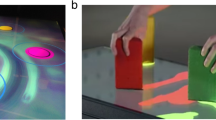Objectives. To assess the efficacy of a set of rehabilitation measures including use of mechanotherapy and cognitive stimulation using tablet PC technology in relation to emotional and behavioral impairments in patients during the acute phase of ischemic stroke. Materials and methods. The study included 100 patients with ischemic stroke admitted to hospital in the acute period. All patients were randomized to two groups: a study group and a control group. The study group (50 patients) received daily robot mechanotherapy using a MOTOmed bedside trainer and tablet PC technology for independent exercises for patients to develop memory, perception, reactions, and counting. Patients of the control group (50 patients) received standard therapy. Functional status was assessed using the modifi ed Rankin scale. Objective evaluation of emotional and behavioral impairments was obtained using psychometric scales (Beck Depression and Anxiety Scales). Results. Use of complex rehabilitation programs in the acute period of ischemic stroke promoted regression of emotional and behavioral impairments (p = 0.0001). The severity of depressive disorders was decreased in patients of the study group by the end of the in-patient period, and further regression in these patients continued throughout the observation period, to the six-month point (p = 0.001). Measures of anxiety showed statistically significant decreases during the whole of the observation period in patients of the study group (p = 0.0001), in contrast to those of the control group, where no changes were seen. Functional recovery was better in patients of the study group, as evidenced by statistically significant changes in mean measures of changes on the Rankin scale. Conclusions. The rehabilitation program presented here, including mechanotherapy and cognitive stimulation using tablet PC technology, is a simple and accessible method for correcting emotional and behavioral impairments in patients in the acute period of ischemic stroke. The results achieved not only persisted over time, but were followed by further improvements in measures at three and six months.
Similar content being viewed by others
References
L. Ayerbe, S. Ayis, C. D. A. Wolfe, and A. G. Rudd, “Natural history, predictors and outcomes of depression after stroke: systematic review and meta-analysis,” Brit. J. Psychiatry, 202, No. 1, 14–21 (2013), https://doi.org/10.1192/bjp.bp.111.107664.
M. A. Kutlubaev and M. L. Hackett, “Part II: predictors of depression after stroke and impact of depression on stroke outcome: an updated systematic review of observational studies,” Int. J. Stroke, 9, No. 8, 1026–1036 (2014), https://doi.org/10.1111/ijs.12356.
T. Kwok, R. S. Lo, E. Wong, et al., “Quality of life of stroke survivors: a 1-year follow-up study,” Arch. Phys. Med. Rehabil., 87, No. 9, 1177–1182 (2006), https://doi.org/10.1016/j.apmr.2006.05.015.
R. G. Robinson and R. E. Jorge, “Post-stroke depression: a review,” Am. J. Psychiatry, 173, No. 3, 221–231 (2016), https://doi.org/10.1176/appi.ajp.2015.15030363.
K. Salter, J. A. McClure, H. Mahon, et al., “Adherence to Canadian best practice recommendations for stroke care: assessment and management of poststroke depression in an Ontario rehabilitation facility,” Top. Stroke Rehabil., 19, No. 2, 132–140 (2012), https://doi.org/10.1310/tsr1902-132.
M. P. Lindsay, M. Bayley, M. D. Hill, et al., Canadian Stroke Best Practice Recommendations, Heart and Stroke Foundation, Ottawa, Ontario, Canada (2014).
M. Flaster, A. Sharma, and M. Rao, “Poststroke depression: a review emphasizing the role of prophylactic treatment and synergy with treatment for motor recovery,” Top. Stroke Rehabil., 20, No. 2, 139–150 (2013), https://doi.org/10.1310/tsr2002-139.
S. E. Kouwenhoven, M. Kirkevold, K. Engedal, and H. S. Kim, “Depression in acute stroke: prevalence, dominant symptoms and associated factors. A systematic literature review,” Disabil. Rehabil., 33, No. 7, 539–556 (2011), https://doi.org/10.3109/09638288.2010.505997.
M. L. Hackett, C. Yapa, V. Parag, and C. S. Anderson, “Frequency of depression after stroke: a systematic review of observational studies,” Stroke, 36, No. 6, 1330–1340 (2005), https://doi.org/10.1161/01.STR.0000165928.19135.35.
L. A. Babkair, “Risk factors for poststroke depression: An integrative review,” J. Neurosci. Nurs., 49, No. 2, 73–84 (2017), https://doi.org/10.1097/JNN.0000000000000271.
M. L. Hackett and K. Pickles, “Part I: frequency of depression after stroke: an updated systematic review and meta-analysis of observational studies,” Int. J. Stroke, 9, No. 8, 1017–1025 (2014), https://doi.org/10.1111/ijs.12357.
H. Dam, “Depression in stroke patients 7 years following stroke,” Acta Psychiatr. Scand., 103, No. 4, 287–293 (2001), https://doi.org/10.1034/j.1600-0447.2001.103004287.x.
C. A. Campbell Burton, J. Murray, J. Holmes, et al., “Frequency of anxiety after stroke: a systematic review and meta-analysis of observational studies,” Int. J. Stroke, 8, No. 7, 545–559 (2013), https://doi.org/10.1111/j.1747-4949.2012.00906.x.
H. Y. Chun, W. N. Whiteley, M. S. Dennis, et al., “Anxiety after stroke: The importance of subtyping,” Stroke, 49, No. 3, 556–564 (2018), https://doi.org/10.1161/STROKEAHA.117.020078.
J. H. White, J. Attia, J. Sturm, et al., “Predictors of depression and anxiety in community dwelling stroke survivors: a cohort study,” Disabil. Rehabil., 36, No. 23, 1975–1982 (2014), https://doi.org/10.3109/09638288.2014.884172.
A. De Ryck, R. Brouns, M. Geurden, et al., “Risk factors for poststroke depression: identifi cation of inconsistencies based on a systematic review,” J. Geriatr. Psychiatry Neurol., 27, No. 3, 147–158 (2014), https://doi.org/10.1177/0891988714527514.
V. Guiraud, T. Gallarda, D. Calvet, et al., “Depression predictors within six months of ischemic stroke: The DEPRESS Study,” Int. J. Stroke, 11, No. 5, 519–525 (2016), https://doi.org/10.1177/1747493016632257.
I. L. Katzan, N. R. Thompson, K. Uchino, and B. Lapin, “The most affected health domains after ischemic stroke,” Neurology, 90, No. 16, 1364–1371 (2018), https://doi.org/10.1212/WNL.0000000000005327.
R. G. Robinson and R. E. Jorge, “Post-stroke depression: a review,” Am. J. Psychiatry, 173, No. 3, 221–231 (2016), https://doi.org/10.1176/appi.ajp.2015.15030363.
A. Nickel and G. Thomalla, “Post-stroke depression: Impact of lesion location and methodological limitations – A topical review,” Front. Neurol., 8, 498 (2017), https://doi.org/10.3389/fneur.2017.00498.
Y. Zhang, H. Zhao, Y. Fang, et al., “The association between lesion location, sex and poststroke depression: Meta-analysis,” Brain Behav., 7, No. 10, e00788 (2017), https://doi.org/10.1002/brb3.788.
N. Wei, W. Yong, X. Li, et al., “Post-stroke depression and lesion location: a systematic review,” J. Neurol., 262, No. 1, 81–90 (2015), https://doi.org/10.1007/s00415-014-7534-1.
H. Ihle-Hansen, B. Thommessen, M. W. Fagerland, et al., “Effect on anxiety and depression of a multifactorial risk factor intervention program after stroke and TIA: a randomized controlled trial,” Aging Ment. Health, 18, No. 5, 540–546 (2014), https://doi.org/10.1080/13607863.2013.824406.
S. B. Wang, Y. Y. Wang, Q. E. Zhang, et al., “Cognitive behavioral therapy for post-stroke depression: A meta-analysis,” J. Affect. Disord., 235, 589–596 (2018), https://doi.org/10.1016/j.jad.2018.04.011.
S. K. Simblett, M. Yates, A. P. Wagner, et al., “Computerized cognitive behavioral therapy to treat emotional distress after stroke: A feasibility randomized controlled trial,” JMIR Ment. Health, 4, No. 2, e16 (2017), https://doi.org/10.2196/mental.6022.
R. De Luca, M. Torrisi, A. Piccolo, et al., “Improving post-stroke cognitive and behavioral abnormalities by using virtual reality: A case report on a novel use of nirvana,” Appl. Neuropsychol. Adult, 25, No. 6, 581–585 (2018), https://doi.org/10.1080/23279095.2017.1338571.
V. I. Sheregeshev, Yu. V. Plyasova, S. V. Kotov, et al., “Optimization of rehabilitation procedure in a patient with acute stroke based on mechanotherapy and cognitive stimulation with the use of tablet PC technology,” Al’manakh Klin. Med., 44, No. 3, 369–375 (2016), www.monikiweb.ru, https://doi.org/10.18786/2072-0505-2016-44-3-369-375.
E. Lattari, H. Budde, F. Paes, Neto GAM, et al., “Effects of aerobic exercise on anxiety symptoms and cortical activity in patients with panic disorder: A pilot study,” Clin. Pract. Epidemiol. Ment. Health, 14, 11–25 (2018), https://doi.org/10.2174/1745017901814010011.
M. Moriya, C. Aoki, and K. Sakatani, “Effects of physical exercise on working memory and prefrontal cortex function in post-stroke patients,” Adv. Exp. Med. Biol.,;923:203–208 (2016), https://doi.org/10.1007/978-3-319-38810-6_27.
A. Jorm, “The Informant Questionnaire on Cognitive Decline in the Elderly (IQCODE): a review,” Int. Psychogeriatr., 16, No. 3, 1–19 (2004).
Author information
Authors and Affiliations
Corresponding author
Additional information
Translated from Zhurnal Nevrologii i Psikhiatrii imeni S. S. Korsakova, Vol. 119, No. 4, Iss. 1, pp. 26–31, April, 2019.
Rights and permissions
About this article
Cite this article
Kotov, S.V., Isakova, E.V. & Sheregeshev, V.I. Possibilities for Correcting Emotional and Behavioral Impairments in Stroke Patients during Rehabilitation Therapy. Neurosci Behav Physi 50, 156–161 (2020). https://doi.org/10.1007/s11055-019-00882-1
Received:
Published:
Issue Date:
DOI: https://doi.org/10.1007/s11055-019-00882-1




